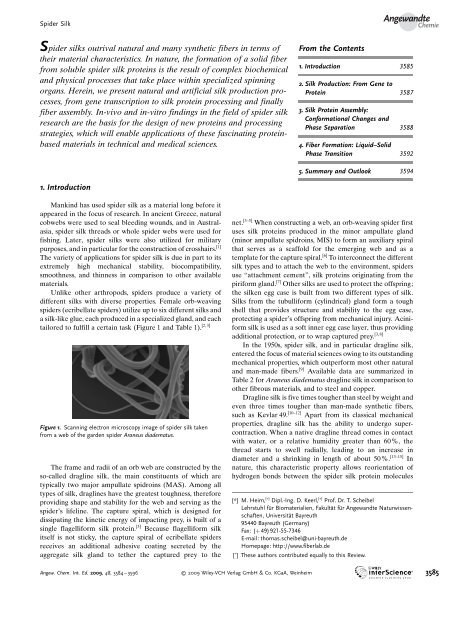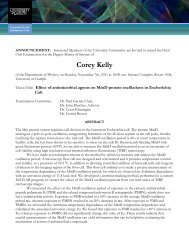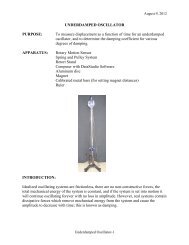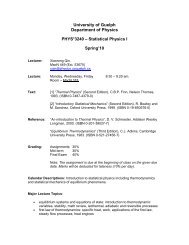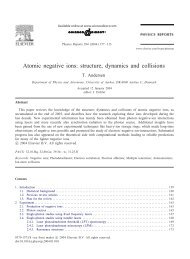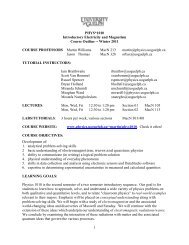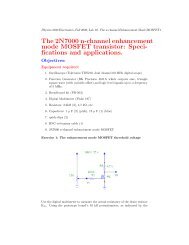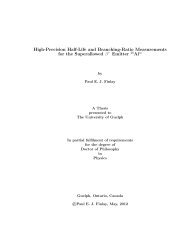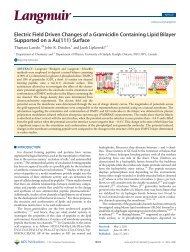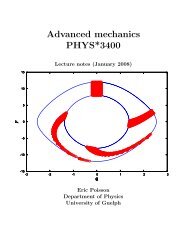Spider Silk: From Soluble Protein to Extraordinary Fiber - Physics
Spider Silk: From Soluble Protein to Extraordinary Fiber - Physics
Spider Silk: From Soluble Protein to Extraordinary Fiber - Physics
Create successful ePaper yourself
Turn your PDF publications into a flip-book with our unique Google optimized e-Paper software.
<strong>Spider</strong> <strong>Silk</strong><br />
<strong>Spider</strong> silks outrival natural and many synthetic fibers in terms of<br />
their material characteristics. In nature, the formation of a solid fiber<br />
from soluble spider silk proteins is the result of complex biochemical<br />
and physical processes that take place within specialized spinning<br />
organs. Herein, we present natural and artificial silk production processes,<br />
from gene transcription <strong>to</strong> silk protein processing and finally<br />
fiber assembly. In-vivo and in-vitro findings in the field of spider silk<br />
research are the basis for the design of new proteins and processing<br />
strategies, which will enable applications of these fascinating proteinbased<br />
materials in technical and medical sciences.<br />
1. Introduction<br />
Mankind has used spider silk as a material long before it<br />
appeared in the focus of research. In ancient Greece, natural<br />
cobwebs were used <strong>to</strong> seal bleeding wounds, and in Australasia,<br />
spider silk threads or whole spider webs were used for<br />
fishing. Later, spider silks were also utilized for military<br />
purposes, and in particular for the construction of crosshairs. [1]<br />
The variety of applications for spider silk is due in part <strong>to</strong> its<br />
extremely high mechanical stability, biocompatibility,<br />
smoothness, and thinness in comparison <strong>to</strong> other available<br />
materials.<br />
Unlike other arthropods, spiders produce a variety of<br />
different silks with diverse properties. Female orb-weaving<br />
spiders (ecribellate spiders) utilize up <strong>to</strong> six different silks and<br />
a silk-like glue, each produced in a specialized gland, and each<br />
[2, 3]<br />
tailored <strong>to</strong> fulfill a certain task (Figure 1 and Table 1).<br />
Figure 1. Scanning electron microscopy image of spider silk taken<br />
from a web of the garden spider Araneus diadematus.<br />
The frame and radii of an orb web are constructed by the<br />
so-called dragline silk, the main constituents of which are<br />
typically two major ampullate spidroins (MAS). Among all<br />
types of silk, draglines have the greatest <strong>to</strong>ughness, therefore<br />
providing shape and stability for the web and serving as the<br />
spider s lifeline. The capture spiral, which is designed for<br />
dissipating the kinetic energy of impacting prey, is built of a<br />
single flagelliform silk protein. [3] Because flagelliform silk<br />
itself is not sticky, the capture spiral of ecribellate spiders<br />
receives an additional adhesive coating secreted by the<br />
aggregate silk gland <strong>to</strong> tether the captured prey <strong>to</strong> the<br />
Angew. Chem. Int. Ed. 2009, 48, 3584 – 3596 2009 Wiley-VCH Verlag GmbH & Co. KGaA, Weinheim<br />
<strong>From</strong> the Contents<br />
Angewandte<br />
Chemie<br />
1. Introduction 3585<br />
2. <strong>Silk</strong> Production: <strong>From</strong> Gene <strong>to</strong><br />
<strong>Protein</strong> 3587<br />
3. <strong>Silk</strong> <strong>Protein</strong> Assembly:<br />
Conformational Changes and<br />
Phase Separation 3588<br />
4. <strong>Fiber</strong> Formation: Liquid–Solid<br />
Phase Transition 3592<br />
5. Summary and Outlook 3594<br />
net. [3–5] When constructing a web, an orb-weaving spider first<br />
uses silk proteins produced in the minor ampullate gland<br />
(minor ampullate spidroins, MIS) <strong>to</strong> form an auxiliary spiral<br />
that serves as a scaffold for the emerging web and as a<br />
template for the capture spiral. [6] To interconnect the different<br />
silk types and <strong>to</strong> attach the web <strong>to</strong> the environment, spiders<br />
use “attachment cement”, silk proteins originating from the<br />
piriform gland. [7] Other silks are used <strong>to</strong> protect the offspring;<br />
the silken egg case is built from two different types of silk.<br />
<strong>Silk</strong>s from the tubulliform (cylindrical) gland form a <strong>to</strong>ugh<br />
shell that provides structure and stability <strong>to</strong> the egg case,<br />
protecting a spider s offspring from mechanical injury. Aciniform<br />
silk is used as a soft inner egg case layer, thus providing<br />
[3, 8]<br />
additional protection, or <strong>to</strong> wrap captured prey.<br />
In the 1950s, spider silk, and in particular dragline silk,<br />
entered the focus of material sciences owing <strong>to</strong> its outstanding<br />
mechanical properties, which outperform most other natural<br />
and man-made fibers. [9] Available data are summarized in<br />
Table 2 for Araneus diadematus dragline silk in comparison <strong>to</strong><br />
other fibrous materials, and <strong>to</strong> steel and copper.<br />
Dragline silk is five times <strong>to</strong>ugher than steel by weight and<br />
even three times <strong>to</strong>ugher than man-made synthetic fibers,<br />
such as Kevlar 49. [10–12] Apart from its classical mechanical<br />
properties, dragline silk has the ability <strong>to</strong> undergo supercontraction.<br />
When a native dragline thread comes in contact<br />
with water, or a relative humidity greater than 60%, the<br />
thread starts <strong>to</strong> swell radially, leading <strong>to</strong> an increase in<br />
diameter and a shrinking in length of about 50 %. [13–15] In<br />
nature, this characteristic property allows reorientation of<br />
hydrogen bonds between the spider silk protein molecules<br />
[*] M. Heim, [+] Dipl.-Ing. D. Keerl, [+] Prof. Dr. T. Scheibel<br />
Lehrstuhl für Biomaterialien, Fakultät für Angewandte Naturwissenschaften,<br />
Universität Bayreuth<br />
95440 Bayreuth (Germany)<br />
Fax: (+ 49)921-55-7346<br />
E-mail: thomas.scheibel@uni-bayreuth.de<br />
Homepage: http://www.fiberlab.de<br />
[ + ] These authors contributed equally <strong>to</strong> this Review.<br />
3585


